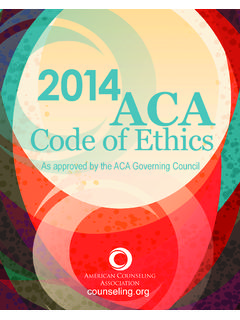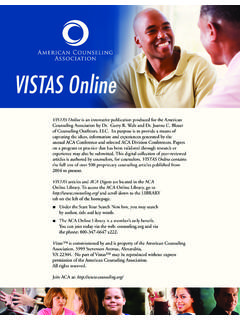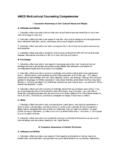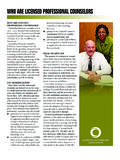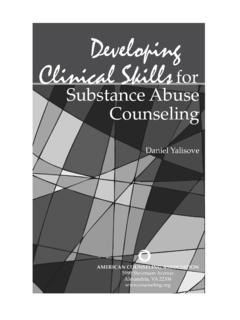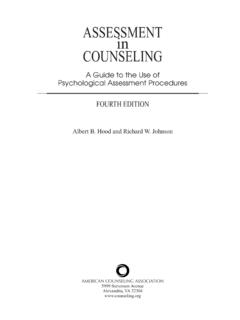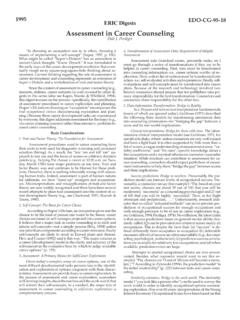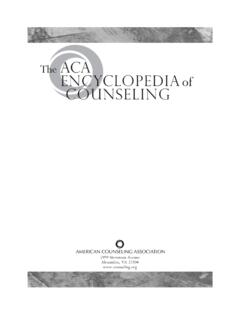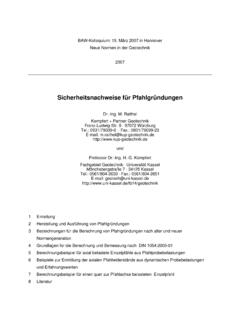Transcription of April 1994 EDO-CG-94-08 ERIC Digest
1 April 1994 ERIC Digest EDO-CG-94-08 . Models of Clinical Supervision George R. Leddick Overview zation, individual differences, theoretical orientation, Clinical supervision is the construction of individu- treatment goals and plans, and professional ethics. Help- alized learning plans for supervisees working with cli- ing supervisees identify their own strengths and growth ents. The systematic manner in which supervision is areas enables them to be responsible for their life-long applied is called a model. Both the Standards for Su- development as both therapists and supervisors. pervision (1990) and the Curriculum Guide for Counsel- ing Supervision (Borders et al.)
2 , 1991) identify knowledge of models as fundamental to ethical practice. Integrated Models Supervision routines, beliefs, and practices began Because many therapists view themselves as eclec- emerging as soon as therapists wished to train others tic, integrating several theories into a consistent prac- (Leddick & Bernard, 1980). The focus of early training, tice, some models of supervision were designed to be however, was on the efficacy of the particular theory ( employed with multiple therapeutic orientations. behavioral, psychodynamic, or client-centered therapy). Bernard's (Bernard & Goodyear, 1992) Discrimination Supervision norms were typically conveyed indirectly Model purports to be a-theoretical.
3 It combines an during the rituals of an apprenticeship. As supervision attention to three supervisory roles with three areas of became more purposeful, three types of models emerged. focus. Supervisors might take on a role of teacher when These were: (1) developmental models, (2) integrated they directly lecture, instruct, and inform the supervisee. models, and (3) orientation-specific models. Supervisors may act as counselors when they assist supervisees in noticing their own blind spots or the manner in which they are unconsciously hooked by a Developmental Models client's issue. When supervisors relate as colleagues dur- Underlying developmental models of supervision is ing co-therapy they might act in a consultant role.
4 Each the notion that we each are continuously growing, in fits of the three roles is task-specific for the purpose of iden- and starts, in growth spurts and patterns. In combining tifying issues in supervision. Supervisors must be sensi- our experience and hereditary predispositions we develop tive toward an unethical reliance on dual relationships. strengths and growth areas. The object is to maximize For example, the purpose of adopting a counselor role and identify growth needed for the future. Thus, it is in supervision is the identification of unresolved issues typical to be continuously identifying new areas of growth clouding a therapeutic relationship.
5 If these issues in a life-long learning process. Worthington (1987) require ongoing counseling, supervisees should pursue reviewed developmental supervision models and noted that work with their own therapists. patterns. Studies revealed the behavior of supervisors The Discrimination Model also highlights three changed as supervisees gained experience, and the areas of focus for skill building: process, conceptualiza- supervisory relationship also changed. There appeared tion, and personalization. Process issues examine how to be a scientific basis for developmental trends and pat- communication is conveyed. For example, is the super- terns in supervision.
6 Visee reflecting the client's emotion, did the supervisee Stoltenberg and Delworth (1987) described a devel- reframe the situation, could the use of paradox help the opmental model with three levels of supervisees: begin- client be less resistant? Conceptualization issues include ning, intermediate, and advanced. Within each level the how well supervisees can explain their application of a authors noted a trend to begin in a rigid, shallow, imita- specific theory to a particular case how well they see tive way and move toward more competence, self-assur- the big picture as well as what reasons supervisees ance, and self-reliance for each level.
7 Particular attention may have for what to do next. Personalization issues is paid to (1) self-and-other awareness, (2) motivation, and pertain to counselors' use of their persons in therapy, in (3) autonomy. For example, typical development in order that all involved are nondefensively present in the beginning supervisees would find them relatively depen- relationship. For example, my usual body language might dent on the supervisor to diagnose clients and establish be intimidating to some clients, or you might not notice plans for therapy. Intermediate supervisees would your client is physically attracted to you. depend on supervisors for an understanding of difficult The Discrimination Model is primarily a training clients, but would chafe at suggestions about others.
8 Re- model. It assumes each of us now have habits of attend- sistance, avoidance, or conflict is typical of this stage, ing to some roles and issues mentioned above. When because supervisee self-concept is easily threatened. you identify your customary practice, you can then re- Advanced supervisees function independently, seek con- mind yourself of the other two categories. In this way, sultation when appropriate, and feel responsible for their you choose interventions geared to the needs of the su- correct and incorrect decisions. pervisee instead of your own preferences and learning Once you understand that these levels each include style.
9 Three processes (awareness, motivation, autonomy), Stoltenberg and Delworth (1987) then highlight content of eight growth areas for each supervisee. The eight Orientation-Specific Models areas are: intervention, skills competence, assessment Counselors who adopt a particular brand of therapy techniques, interpersonal assessment, client conceptuali- ( Adlerian, solution-focused, behavioral, etc.). oftentimes believe that the best supervision is analysis of Summary practice for true adherence to the therapy. The situation is analogous to the sports enthusiast who believes the best fu- Are the major models of supervision mutually exclusive, ture coach would be a person who excelled in the same sport or do they share common ground?
10 Models attend systemati- at the high school, college, and professional levels. Ekstein cally to: a safe supervisory relationship, task-directed struc- and Wallerstein (cited in Leddick & Bernard, 1980) described ture, methods addressing a variety of learning styles, mul- psychoanalytic supervision as occurring in stages. During tiple supervisory roles, and communication skills enhancing the opening stages the supervisee and supervisor eye each listening, analyzing, and elaboration. As with any model, other for signs of expertise and weakness. This leads to each your own personal model of supervision will continue to person attributing a degree of influence or authority to the grow, change, and transform as you gain experience and in- other.
